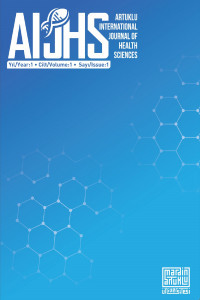Periferik Fasiyal Paralizi Olan Hastalarda Anksiyete, Depresyon, Cinsel Fonksiyon Bozukluğu ve Hastalık Aktivitesi ile Olan İlişkisi
Periferik fasiyal paralizi, ağırlıklı olarak ana işlevi yüz ifadesi kaslarını kontrol etmek olan hem motor hem de duyusal liflerle karışık bir sinir olan fasiyal sinirin (VII. kraniyal sinir) tek taraflı bir bozukluğudur. Periferik fasiyal Paraliz oluşturduğu klinik bulgular sonucu hastalarda kaygı artışı ve depresif ruh hali oluşturabilmektedir. Bu çalışmanın amacı periferik fasiyal paralizli hastalarda anksiyete, depresyon ve cinsel fonksiyon arasındaki ilişkinin değerlendirilmesidir. Hastanemizde 60 katılımcı ile hastaların paralizisi House-Brackmann skalası ile derecelendirildi. Duygu Durumu Hastane Anksiyete ve Depresyon ölçeği ile belirlendi. Cinsel fonksiyonları, Arizona Cinsel Yaşam Ölçeği ile değerlendirildi. Çalışmamız için yola çıkarken ileri evre fasial paralizili hastalarda depresyon ve anksiyetenin daha fazla olacağını umuyorduk ancak korelasyon testlerinde belirgin bir fark saptanmadı. Yine de vaka grubumuzda kontrol grubuna göre depresyon ve anksiyete skorlarında bozulma gördük. Hastalığın evresine göre korelasyon göstermemesi vaka sayımızın azlığı ile açıklanabilir. Öneri olarak daha yüksek vaka serileri ile yeniden yapılacak cinsel fonksiyon değerlendirmeleri ilerde bu hastalığın psikolojik temellerine de ışık tutabilir.
Anahtar Kelimeler:
Periferik fasiyal paralizi, Anksiyete, Cinsel fonksiyon
The Association Between Anxiety, Depression, Sexual Dysfunction and Disease Activity in Patients with Peripheral Facial Paralysis
Peripheral facial palsy is a predominantly unilateral disorder of the facial nerve (VII. cranial nerve), a mixed nerve with both motor and sensory fibers whose main function is to control the muscles of facial expression. As a result of the clinical findings of peripheral facial paralysis, patients with increased anxiety and depressive mood may cause increased anxiety. The aim of this study was to evaluate the relationship between anxiety, depression and sexual function in patients with peripheral facial palsy. The paralysis of the patients in our hospital was graded with the House-Brackmann scale with 60 participants. Emotional status was determined by the Hospital Anxiety and Depression scale. Sexual functions were evaluated with the Arizona Sexual Life Scale. At the beginning of this study, we expected that depression and anxiety would be higher in patients with advanced facial paralysis, however, no significant difference was found in correlation tests. However, we observed deterioration in depression and anxiety scores in our case group compared to the control group. The lack of correlation according to the stage of the disease can be explained by the small number of cases. As a suggestion, sexual function evaluations to be made with higher case series may shed light on the psychological basis of this disease in the future.
Keywords:
Peripheral facial paralysis, Anxiety, Sexual dysfunction,
___
- 1. Cuenca-Martínez, F., Zapardiel-Sánchez, E., Carrasco-González, E., La Touche, R., & Suso-Martí, L. (). Assessing anxiety, depression and quality of life in patients with peripheral facial palsy: a systematic review. Peer J. 2020; 8: 10449.
- 2. Gürbüzler L, Karamert R, and Bayazıt YA. Periferik fasiyal paralizi. Turkiye Klinikleri J Surg Med Sci. 2006; 2(28): 36-42. (2006).
- 3. Pouwels, Sjaak, et al. Hastane anksiyete ve depresyon ölçeği kullanılarak yüz felçli hastalarda psikolojik sıkıntının değerlendirilmesi. Plastik, Rekonstrüktif ve Estetik Cerrahi Dergisi. 2016; 69(8): 1066-1071.
- 4. Çıraklı S. Effect of etiological factors on treatment success of pediatric facial paralysis: Success of facial paralysis in children. Medicine. 2021; 100(50):1-5.
- 5. Kucur C. et al. Tekrarlayan periferik fasiyal paralizili hastalarda ayırıcı tanı. Van Tıp Dergisi. 2015; 22(3): 159-165.
- 6. Kucur, C., Baştürk, A., Gürsel AO. Bell paralizisi: Tanı, tedavi ve klinik takibi. Bakırköy Tıp Dergisi. 2011; 7(2): 56-59.
- 7. Medica EM. Give me a kiss! An integrative rehabilitative training program with motor imagery and mirror therapy for recovery of facial palsy. European Journal Of Physical And Rehabilitation Medicine. 2019; 1-38.
- 8.Mengi E. et al. Validation of the Turkish version of the facial nerve grading system 2.0. Turkish Archives of Otorhinolaryngology. 2020; 58(2): 106.
- 9. House JW, Brackmann DE. Facial nerve grading system. Otolaryngol Head Neck Surg. 1985; 93: 184-193.
- 10. Küçükelçi DT. Hastane anksiyete ve depresyon ölçeği (HADS) üzerine bir çalışma. Yaşam Becerileri Psikoloji Dergisi. 2019; 3(5): 85-91.
- 11. Pouwels S. et al. Assessing psychological distress in patients with facial paralysis using the Hospital Anxiety and Depression Scale. Journal of Plastic, Reconstructive & Aesthetic Surgery. 2016; 69(8): 1066-1071.
- 12. Snaith RP. The hospital anxiety and depression scale. Health and Quality Of Life Outcomes 2003; 1(1): 1-4.
- 13. Çoban TK, Dinç A. İnfertilitenin cinsel yaşam üzerine etkisinin incelenmesi. Uluslararası Klinik Araştırmalar Dergisi. 2013; 1(2): 46-53.
- 14. A. McGahuey, Alan J. Gelenberg, Cindi A. Laukes, Francisco A. Moreno, Pedro L. Delgado, Kathy M. McKnight, Rachel Manber, Cynthia. The Arizona sexual experience scale (ASEX): reliability and validity. Journal of Sex &Marital Therapy. 2000; 26(1): 25-40
- 15. Kang NR, Tark MR, Byun SM, Ko WS, Yoon HJ. A Clinical analysis on 250 cases of inpatients with facial paralysis. The Journal of Korean Medicine Ophthalmology and Otolaryngology and Dermatology. 2010; 23: 109-121.
- 16. Garanhani MR, Rosa JC, Capelli AD, Ribeiro MC. Physical therapy in peripheral facial paralysis: retrospective study. Brazilian Journal Of Otorhinolaryngology. 2007; 73: 106-109.
- 17. Rowlands S, Hooper R, Hughes R, Burney P. Th e epidemiology and treatment of Bell’s palsy in the UK. European Journal of Neurology. 2002; 9: 63-67.
- 18. Valença MM, Valença LP, Lima MC. Idiopathic facial paralysis (Bell´ s palsy): a study of 180 patients. Arquivos de Neuro-Psiquiatria. 2001; 59:733-739.
- Başlangıç: 2021
- Yayıncı: Mardin Artuklu Üniversitesi
Sayıdaki Diğer Makaleler
Adrenal Adenomu Taklit Eden Bir Myelolipom Olgusu
Semra DEMİRLİ ATICI, Ayberk DURSUN, Serdar AYDOĞAN, Mehmet ÜSTÜN
Uzaktan Eğitimin Uygulamalı Alanlarda Eğitim Gören Öğrencilerin Anksiyete Düzeyine Etkisi
Merve BAT TONKUŞ, Cansu BAKIRHAN
